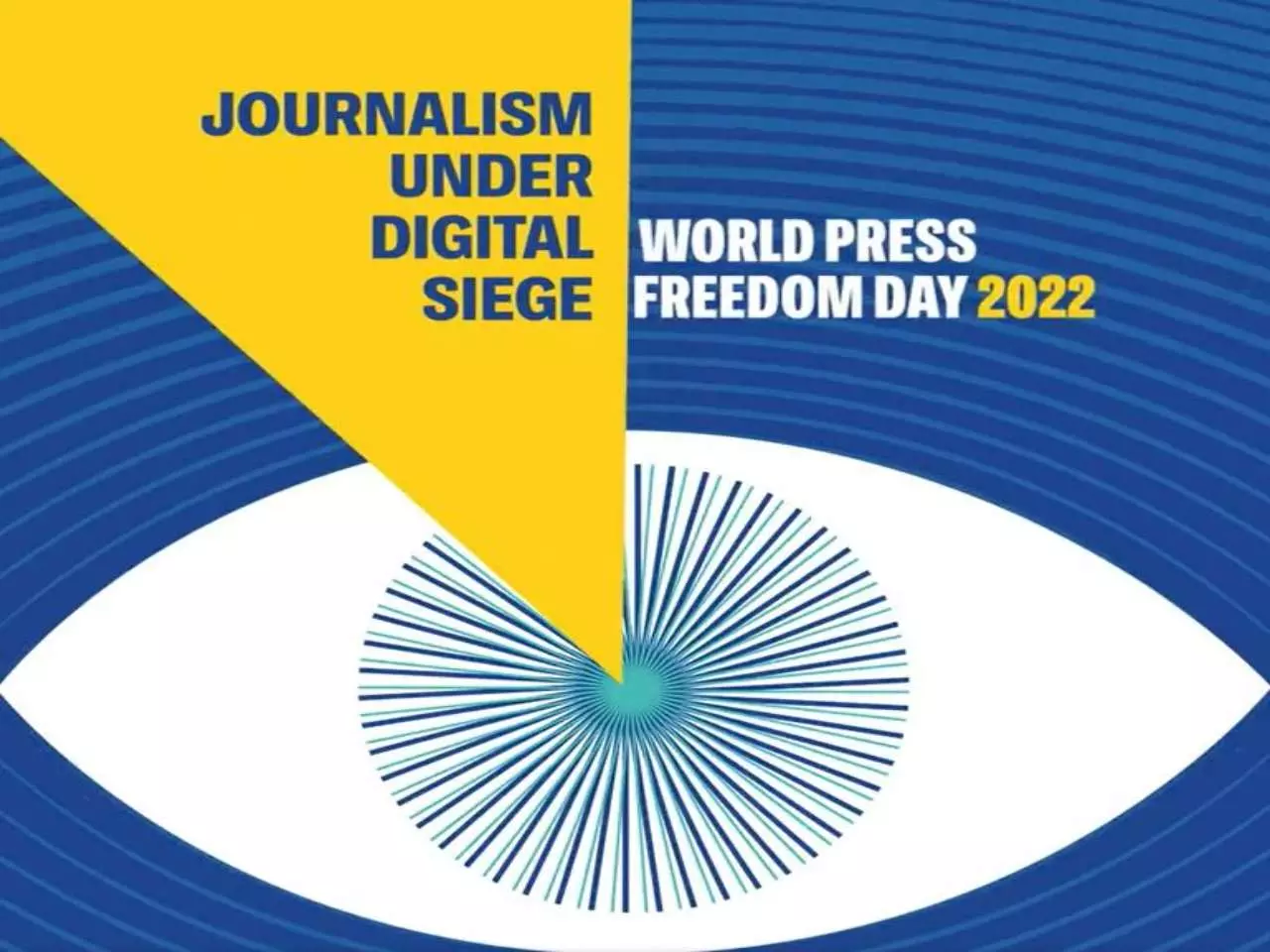
By Admire Mare EVERY year the world celebrates World Press Freedom Day on May 3, which was set aside to promote the fundamental principles of Press freedom, to evaluate the state of Press freedom, to defend the media from attacks on their independence and to pay tribute to journalists who have lost their lives in the line of duty.
It was proclaimed by the UN General Assembly in 1993. This was after a recommendation was adopted at the 26th session of UNESCO’s General Conference in 1991. In many respects, the proclamation was in response to a clarion call by African journalists who in 1991 came up with the historic Windhoek Declaration.
The day also serves as a platform to take stock of gains and losses registered in pursuit of Press freedom and professional ethics.
In honour of the historic milestone, the 2021 World Press Freedom Day was held in Windhoek, Namibia. At this commemorative gathering, the Windhoek +30 Declaration was adopted.
It took forward the spirit of the 1991 Windhoek Declaration, but also foregrounded the issue of media viability in the age of digital disruptions, the proliferation and amplification of disinformation and hate speech, transparency and accountability of platform companies and empowerment of citizens with media and information literacy.
This year’s celebrations are running under the theme: “Journalism under digital siege”. While the theme is meant to signpost the multiple ways in which journalism is threatened by surveillance and online-orchestrated attacks on journalists, and the consequences of all this on public trust in digital communications, it is important to demonstrate that this “digital siege” manifests itself in various ways.
I will return to this theme later, for now I want to briefly review the state of media freedom in Zimbabwe. Ever since, the “Second Republic” came to power after the military-assisted transition in November 2017, we have witnessed notable changes at the level of legislative and practical reforms.
Legislative and practical reforms
- Chamisa under fire over US$120K donation
- Mavhunga puts DeMbare into Chibuku quarterfinals
- Pension funds bet on Cabora Bassa oilfields
- Councils defy govt fire tender directive
Keep Reading
At the legislative level, the notorious Access to Information and Protection of Privacy Act (Aippa) has since been replaced by the Freedom of Information Act. This has brought some modicum of media freedom despite challenges still faced by journalists working for the private media.
The Zimbabwe Media Commission Act was also passed into law. This law allowed for the alignment with the 2013 Constitution especially section 248. Unlike under Aippa, where the Zimbabwe Media Commission (ZMC) was established through a broad and overreaching legislative framework, through the ZMC Act, the government wanted to have a standalone law. Its mandate is stipulated in section 249 of the Constitution.
The government is busy working on the amendments of the Broadcasting Services Act which was passed in 2001. Again, this move is meant to align the law with the 2013 Constitution, but also to modernise it in line with changes in the broadcasting sector characterised by livestreaming, podcasting, and the rise of platform companies (such as Netflix, Amazon Prime, Showmax and so forth). It is envisaged that the Bill will endeavour to address the lack of diversity and plurality in the broadcasting sector.
Furthermore, there are media reports which show that government is working on the Media Practitioners Bill. This proposed law has attracted a lot of bad Press among journalists. Although the government has framed it as a law meant to operationalise the co-regulation system (self and statutory regulatory mechanism), there is deep-seated fear that it could be abused to control and muzzle the operations of journalists.
Other pieces of legislation which are still under consideration include the Data Protection Bill, Protection of Personal Information Bill and the Cybersecurity and Cybercrimes Bill. It is not clear whether these are going to eventually be passed as separate laws or as an omnibus, as previously presented. There is need to avoid duplication and over-regulation through these long-anticipated laws. International principles such as necessity, proportionality, legality and user notification should anchor and inform their drafting.
At least 14 community radio stations have been licenced by the Broadcasting Authority of Zimbabwe (Baz). Some of the stations are already on air, while others are busy preparing to launch. Additionally, seven campus radio stations have also been licenced. In this regard, the Great Zimbabwe University campus radio has been a trendsetter. It has become the ultimate model of a successful campus radio station.
On the television front, we have witnessed the licensing of six free to air “private” television stations. These are Zimpapers Television Network (ZTN), Rusununguko Media (Pvt) Ltd (trading as NRTV), Jester Media (3KTV), Accacia Media Group (Kumba TV), Fairtalk Communications (Ke Yona TV) and Channel Dzimbahwe (trading as Channel D). Two of these have begun to broadcast via satellite and social media platforms.
The move sought to end a long-held monopoly enjoyed by the State-owned, Zimbabwe Broadcasting Corporation (ZBC). On its part, ZBC recently launched a new channel known as “Jive TV”‚ which is accessible via digital platforms and digital terrestrial television. The youth-focused music channel is expected to help the national broadcaster to reconnect with its young audiences.
It is evident from the foregoing that notable legislative and practical reforms are underway. However, when one looks at who got the licences then it is plausible to conclude that elite continuity and consolidation has taken place.
Furthermore, policy pronouncements asking community and campus radio stations to stay away from political content also highlights that the “more things change, the more they remain the same”.
Teething problems
There are still issues that require urgent attention. For instance, there is no talk around the repealing of the Official Secrets Act, Interception of Communications Act and the Criminal Codification Act. Media polarisation, media viability, media capture and professionalism are teething problems that continue to lurk in the woods.
Recurrent spates of internet shutdowns and throttling have also cast doubt over government’s sincerity in promoting media and digital freedom. The cost of data remains exorbitantly high when compared to neighbouring countries such as Zambia, Botswana, Namibia and South Africa.
Sporadic harassment of journalists and content creators in the last few months have also been a huge concern. The safety and security of journalists remains tenuous especially during electoral campaigns.
A disrupted media environment
As Zimbabwe celebrates Press Freedom Day, it is imperative to emphasise that the production, distribution and consumption of news and information has significantly changed.
While in the past, mainstream media organisations were the only credible and truthful “drafters of history”‚ nowadays there are several actors in the journalism ecosystem. These include social media influencers, bloggers, vloggers, satirists, comedians, ordinary people, micro-celebrities‚ and the list goes on.
In short, professional journalists are no longer the only priests of the ‘Truth’ in the digital age. This is mostly thanks to the rapid advances in digital technologies. The internet and social media platforms have become integral in the way news and information are gathered, packaged, measured, distributed and consumed.
It is unthinkable for journalists (both professional and non-professional) to conduct their day-to-day news making activities without using the internet, social media platforms and digital devices. It is fair to say, journalism has been irreparably digitised. The relationship between journalism and digital technologies is complex yet fraught with a lot of thorns and thistles.
Unpacking the digital siege
The digital age has created several surveillance possibilities. It has allowed governments and corporate entities to conduct digital surveillance on the activities of journalists and their sources. Through simple and sophisticated smart surveillance devices, it is possible to monitor, categorise, analyse and predict the online behaviours of journalists and their news sources.
Although this violates the right to privacy, the always on smartphones and digital devices have created an environment where confidentiality of news sources is continuously being chipped away. Through EMSI catchers and grabbers, it is possible to monitor the activities of journalists from afar. Thus, while technologies are hailed for opening up spaces for media diversity and pluralism, they also come with their own challenges.
Even when chatting with the news sources and whistleblowers via messaging platforms and emails, there are no guarantees that such confidential information will remain protected. In the absence of the Data Protection Act and Whistleblower Act, media freedom is under threat from a wide range of State and non-State actors in the digital age.
The relationship between publishers and platforms also presents diverse challenges for the enjoyment of media freedom. Platform companies are increasingly tapping into the advertising and news market traditionally monopolised by mainstream media organisations. This has created a media viability crisis not only in Zimbabwe, but across the world. The dog fight for the limited digital advertising cake has negatively affected the viability of traditional media organisations.
The ensuing turf wars between publishers and platforms has also led to accusations and counter-accusations. Publishers have accused platforms of being conveyer belts of fake news and hate speech. Platforms have been criticised for harming democratic institutions and amplifying polarisation. Understandably, calls for the regulation of platforms have grown louder.
Politicians have ceased the opportunity brought by the resurgence of fake news to label all media organisations critical of their actions as “fake media”. The use of the fake news as a weapon is partly blamed for the observed decline in media trust.
Attacks by social media brigades
Another area of “digital siege” relates to the relentless attacks targeting journalists on social platforms such as Twitter, Facebook and WhatsApp. Coordinated campaigns aimed at threatening and discrediting the legitimate work of journalists by social media brigades have spiked in Zimbabwe. Varakashi and Nerrorists have been singled out as the main perpetrators of these campaigns. Twitter has been their hunting ground for some time now.
Female journalists have been on the receiving end of some of these campaigns. Instead of nurturing habitable networking and working spaces for both male and female journalists, social media platforms have provided nameless and faceless trolls with semi-public spaces for harassing and threatening their targets with impunity.
Online misogyny targeting female journalists and politicians often mirror the patriarchal make up of our society. Patriarchy as an ideology and organising principle thrives on female subordination and silencing.
In its various manifestations, online misogyny violates their rights to freedom of expression, freedom of assembly and right to privacy. Thus, as we celebrate Press Freedom Day, it is incumbent upon platform companies to ramp up their efforts focusing on content moderation, removal of bots and unverified accounts and fact-checking.
Be that it is may, because of the limited space here I will not exhaust all the manifestations of “digital siege”, suffice to say that journalism in Zimbabwe finds itself caught in between a rock and a hard place.
On the one hand, digital technologies, as we have seen during the COVID-19 pandemic, have allowed journalists to continue with their public interest duties of informing, educating and entertaining us. On the other hand, the same technologies have made journalists and their sources more vulnerable to surveillance and coordinated attacks.
In order to address these systemic vulnerabilities associated with the “digital siege”‚ there is need for a multistakeholder approach including the government, platform companies, telecommunication operators, regulatory bodies, the parliament, the judiciary, editors and journalists’ associations and the broader public to find ways of minimising harms and insecurities facing media practitioners in Zimbabwe.
More still needs to be done to promote meaningful media and digital freedom in Zimbabwe. It is only through coordinated approaches that journalism can be unshackled from the threats accompanying digital siege. Beyond legislative, policy and practical reforms, we need to deal with media capture, polarisation, unethical conduct, and illicit relationships between journalists and news sources.











